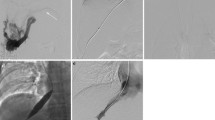Abstract
Purpose
To evaluate the clinical value of accessory hepatic vein (AHV) intervention in the treatment of Budd–Chiari syndrome (BCS).
Patients and Methods
From August 2008 to July 2014, consecutive patients with BCS caused by obstruction of three hepatic veins (HVs) with or without obstruction of inferior vena cava (IVC) were treated by recanalization or transjugular intrahepatic portosystemic shunt in our center. Patients who had the compensatory AHV and successfully underwent recanalization of AHV outflow were enrolled in this retrospective study. The clinical response to AHV drainage was analyzed.
Results
Compensatory AHV was found in 69 of 97 (71.1 %) patients, and 66 patients successfully underwent recanalization of AHV outflow (IVC recanalization, n = 49; AHV recanalization, n = 15; both, n = 2). In total, 78 AHVs were used instead of HV as the hepatic drainage vein after treatment. Fifty-five patients had one AHV, 10 patients had two AHVs, and 1 patient had three AHVs. The average diameter of all AHV stems was 8.0 ± 2.6 mm (range 5–21 mm). Clinical response to AHV drainage was positive in all patients. Patients’ symptoms and liver function improved progressively after treatment. During the follow-up of 3–74 months (average 39.4 ± 11.0 months), 11 patients experienced reobstruction at 6 to 36 months (average 16.8 ± 9.8 months) after treatment.
Conclusion
Compensatory AHV can be effectively used instead of HV for drainage of hepatic blood in patients with BCS. AHV intervention can help to simplify the BCS treatment procedure.


Similar content being viewed by others
References
Qi X, Zhang C, Han G, et al. Prevalence of the JAK2V617F mutation in Chinese patients with Budd–Chiari syndrome and portal vein thrombosis: a prospective study. J Gastroenterol Hepatol. 2012;27(6):1036–43.
Wang H, Sun G, Zhang P, et al. JAK2 V617F mutation and 46/1 haplotype in Chinese Budd–Chiari syndrome patients. J Gastroenterol Hepatol. 2014;29(1):208–14.
Qi X, De Stefano V, Wang J, et al. Prevalence of inherited antithrombin, protein C, and protein S deficiencies in portal vein system thrombosis and Budd–Chiari syndrome: a systematic review and meta-analysis of observational studies. J Gastroenterol Hepatol. 2013;28(3):432–42.
Tripathi D, Macnicholas R, Kothari C, et al. Good clinical outcomes following transjugular intrahepatic portosystemic stent-shunts in Budd–Chiari syndrome. Aliment Pharmacol Ther. 2014;39(8):864–72.
Fitsiori K, Tsitskari M, Kelekis A, Filippiadis D, Triantafyllou K, Brountzos E. Transjugular intrahepatic portosystemic shunt for the treatment of Budd–Chiari syndrome patients: results from a single center. Cardiovasc Intervent Radiol. 2014;37(3):691–7.
Eapen CE, Velissaris D, Heydtmann M, Gunson B, Olliff S, Elias E. Favourable medium term outcome following hepatic vein recanalisation and/or transjugular intrahepatic portosystemic shunt for Budd Chiari syndrome. Gut. 2006;55(6):878–84.
Gao Y, Chen S, Yu C. Applicability of different endovascular methods for treatment of refractory Budd–Chiari syndrome. Cell Biochem Biophys. 2011;61(2):453–60.
Zhang CQ, Fu LN, Xu L, et al. Long-term effect of stent placement in 115 patients with Budd–Chiari syndrome. World J Gastroenterol. 2003;9(11):2587–91.
Cheng D, Xu H, Lu ZJ, et al. Clinical features and etiology of Budd–Chiari syndrome in Chinese patients: a single-center study. J Gastroenterol Hepatol. 2013;28(6):1061–7.
Fu YF, Xu H, Zhang K, Zhang QQ, Wei N. Accessory hepatic vein recanalization for treatment of Budd-Chiari syndrome due to long-segment obstruction of the hepatic vein: initial clinical experience. Diagn Interv Radiol. 2015;21(2):148–53.
Hanaoka J, Shimada M, Uchiyama H, et al. A simple formula to calculate the liver drainage volume of the accessory right hepatic vein using its diameter alone. Surgery. 2009;146(2):264–8.
Tang W, Zhang XM, Yang L, Mitchell DG, Zeng NL, Zhai ZH. Hepatic caudate vein in Budd–Chiari syndrome: depiction by using magnetic resonance imaging. Eur J Radiol. 2011;77(1):143–8.
Buhe S, Miyaki T, Saito T, et al. A study of the accessory hepatic vein to segments VI and VII with a morphological reconsideration of the human liver. Surg Radiol Anat. 2008;30(3):201–7.
Loewe C, Schillinger M, Haumer M, et al. MRA versus DSA in the assessment of occlusive disease in the aortic arch vessels: accuracy in detecting the severity, number, and length of stenoses. J Endovasc Ther. 2004;11(2):152–60.
Xu H, Zu MH, Li GJ, et al. Interventional therapy of Budd–Chiari syndrome with hepatic vein obstruction. Chin J Med Imaging Technol. 2004;20(10):1588–91 (in chinese).
Conflict of interest
All authors including Yu-Fei Fu, Ning Wei, Qian Wu, Qing-Qiao Zhang, Yan-Feng Cui, and Hao Xu of this study declare that they have no conflicts of interest.
Informed Consent
Informed consent was obtained from all individual participants included in the study.
Author information
Authors and Affiliations
Corresponding author
Additional information
Yu-Fei Fu, Ning Wei, and Qian Wu have contributed equally to this study.
Rights and permissions
About this article
Cite this article
Fu, YF., Wei, N., Wu, Q. et al. Use of Accessory Hepatic Vein Intervention in the Treatment of Budd–Chiari Syndrome. Cardiovasc Intervent Radiol 38, 1508–1514 (2015). https://doi.org/10.1007/s00270-015-1105-4
Received:
Accepted:
Published:
Issue Date:
DOI: https://doi.org/10.1007/s00270-015-1105-4




